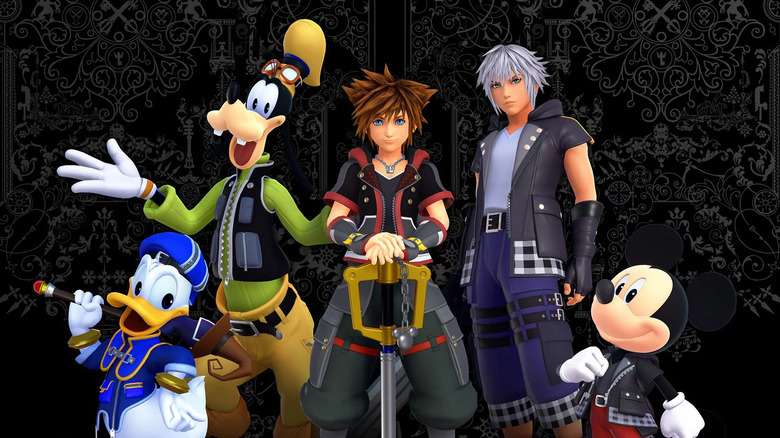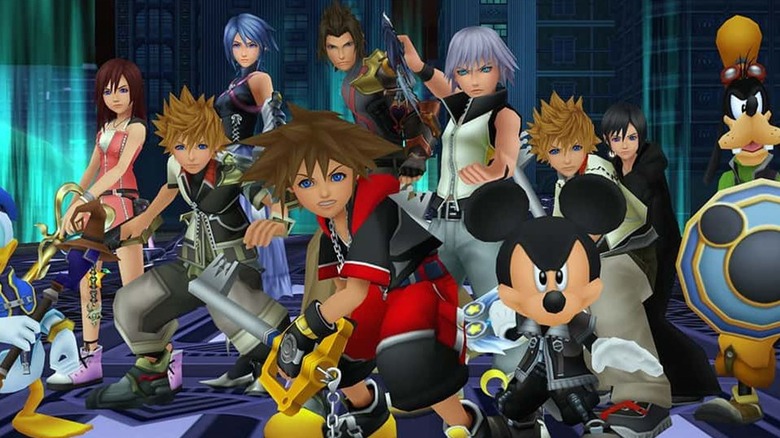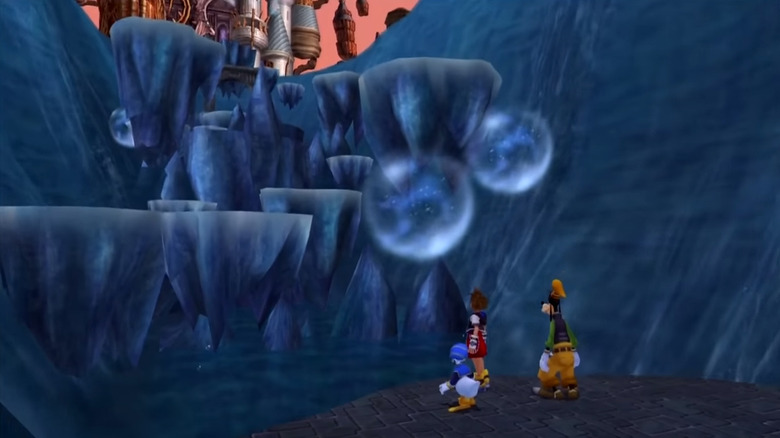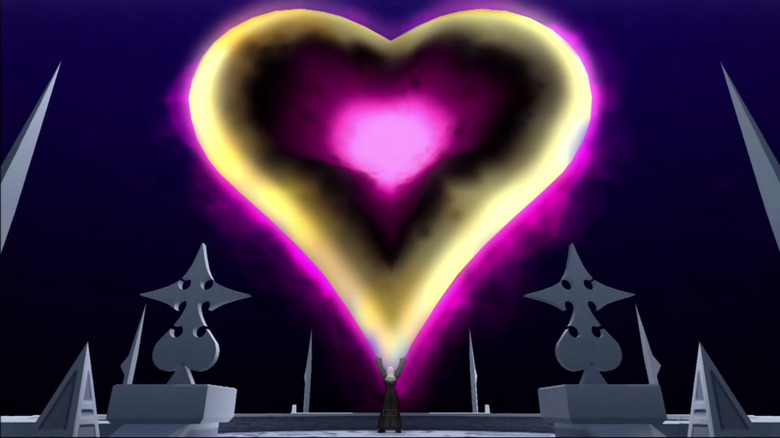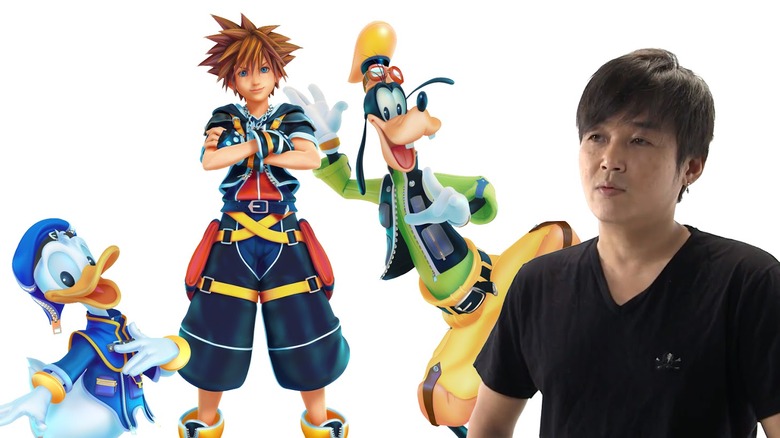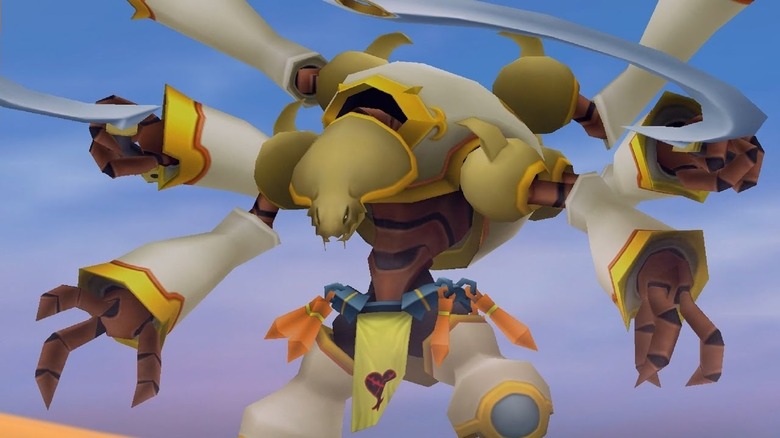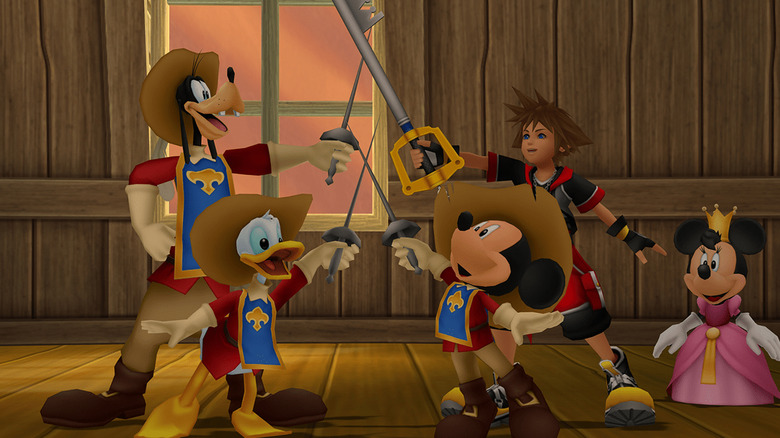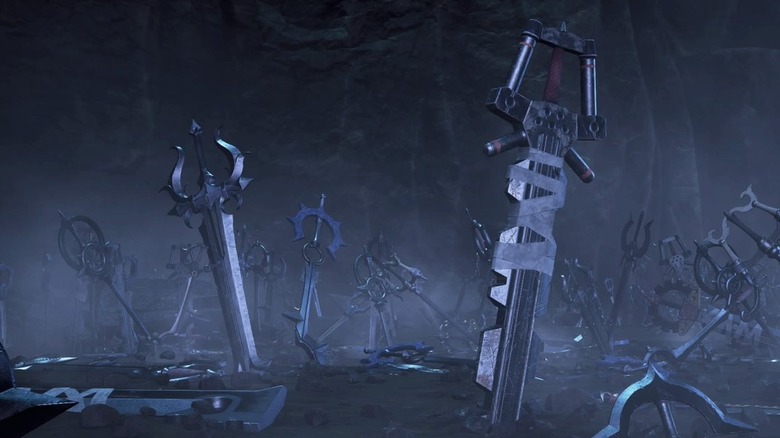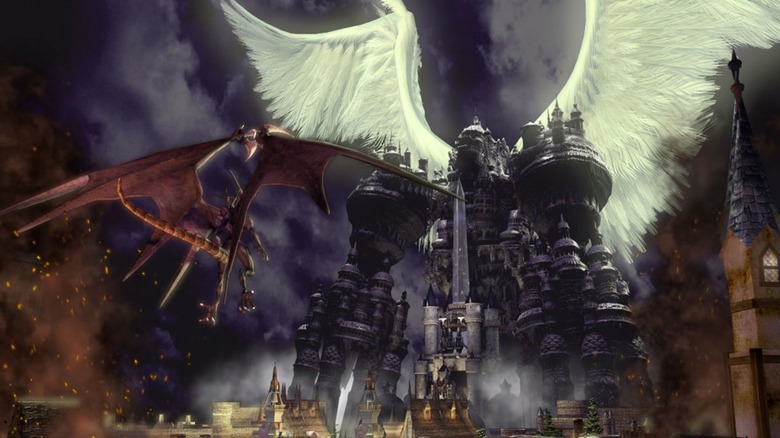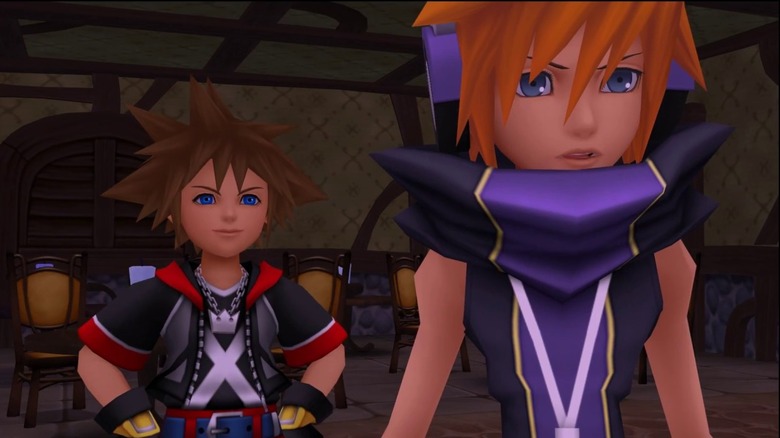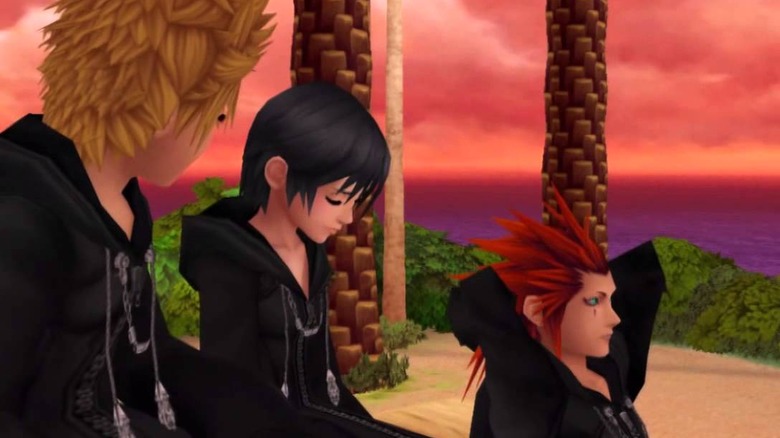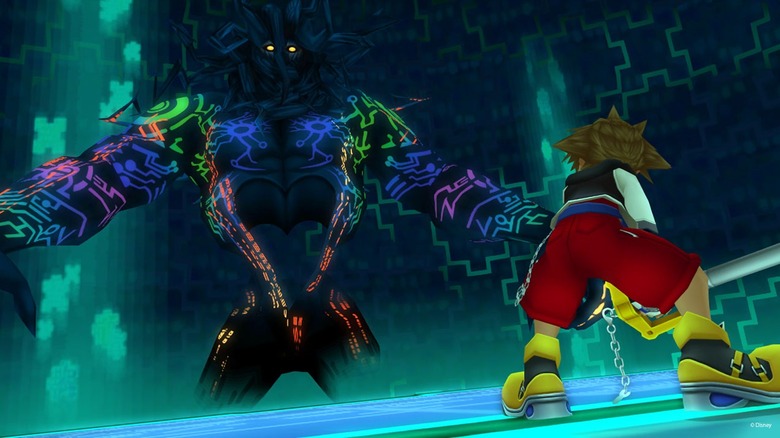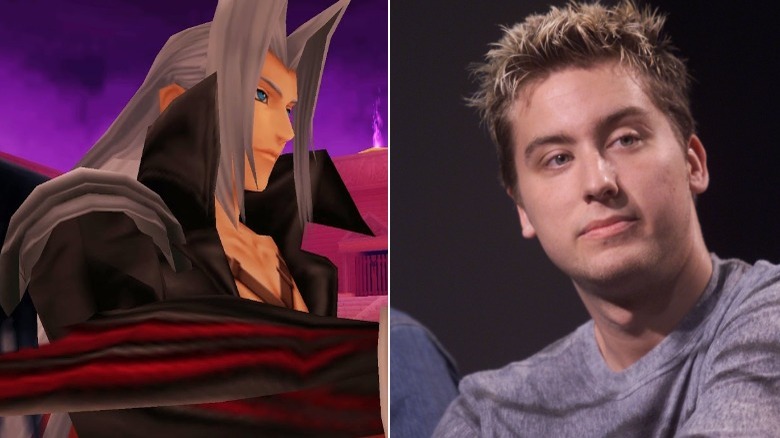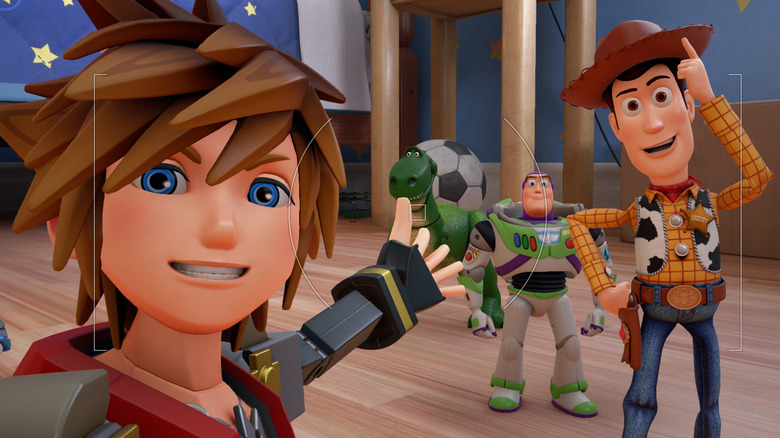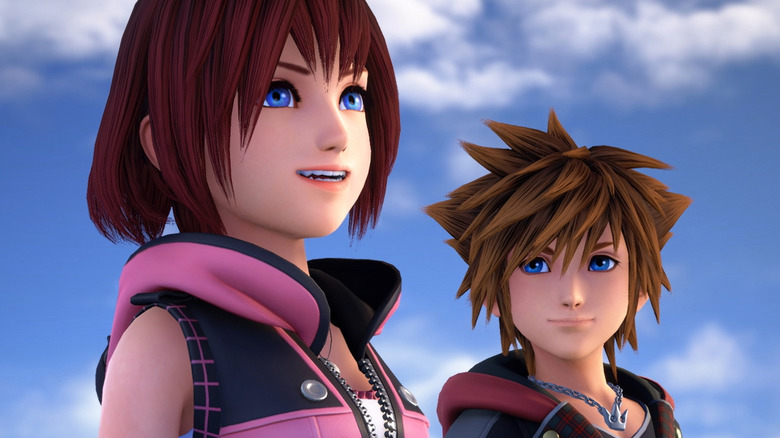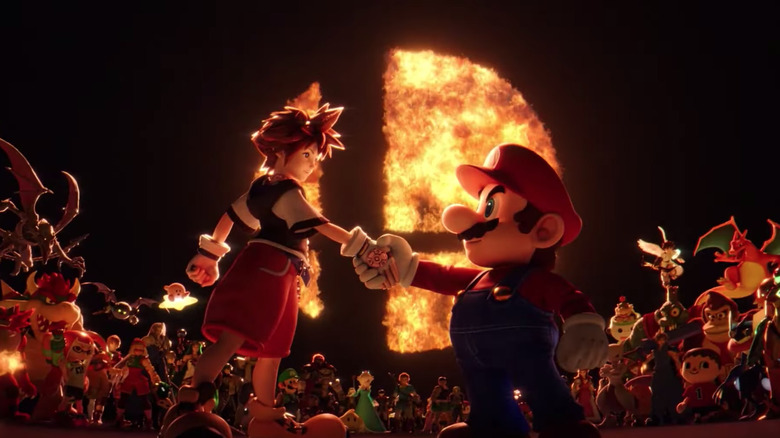The Untold Truth Of Kingdom Hearts
Somehow, Kingdom Hearts is one of the most popular JRPG franchises in the world. It has a community that is steadfast in its dedication to the adventures of a typical teenage protagonist who just happens to form a lasting friendship with Donald Duck and Goofy. The games themselves are downright brilliant, mashing up a combination of Disney worlds and characters with Final Fantasy cameos as though it's the most natural pairing imaginable.
The Kingdom Hearts series is also one of the most complex game sagas around. The franchise's bizarre release schedule and penchant for nonlinear storytelling has made its overall plot a daunting challenge for anyone.
While the games themselves require a lot of homework to understand, the circumstances surrounding Kingdom Hearts' creation are equally complex and fascinating. How did we ever get to the point that a blend of Disney and Final Fantasy became one of the industry's hottest properties? The answer is, predictably, a little convoluted. Here's a look at the untold truth behind Kingdom Hearts.
Kingdom Hearts was meant to be only one game
Yes, the franchise that now boasts more than ten different games was originally meant to be just one. In one of the most hilarious examples of overly modest expectations, Kingdom Hearts director Tetsuya Nomura went into the production believing that Square would only be making the title as a one-off collaboration. After all, how many fans would be interested in the adventures of King Mickey and Sora once the novelty of the combination had worn off?
As it turns out, the answer is pretty much all of Kingdom Hearts' fans and then even more once the game generated buzz post-release. The game obviously over-performed, especially given Nomura's tempered approach to its launch and potential successes. It might be easy to forget now, but Kingdom Hearts was a pretty big gamble at the time, so Nomura's hesitancy to believe it could be a long-term money earner for Square made sense.
Luckily for all involved, Nomura had a contingency plan in the event Kingdom Hearts became a global phenomenon. He'd placed a hidden video at the end of the first game that vaguely set up the direction for a sequel. Rumors began to swirl online about a potential sequel and, when fans had demonstrated enough interest, Square pulled the trigger on making one. Nomura's hidden video was just enough of a tease to spawn the Kingdom Hearts franchise in all of its confusing vastness.
Kingdom Hearts was born in an elevator
Are you familiar with the concept of the elevator pitch? It's a philosophy that suggests any good, well-thought out idea can be summarized to a potential investor in the time it takes to ride an elevator. It appears that Shinji Hashimoto, a Square game producer, took the idea a little too literally, however.
The story goes that Square and Disney's Japanese offices shared the same building at the time. Square, and in particular Hashimoto and Nomura, had wanted to partner with Disney on something for a while, but hadn't found the right time or angle with which to approach the company. As fate would have it, Hashimoto ended up getting on an elevator with a key Disney executive and, with no one else around, Hashimoto went for it. He pitched the partnership idea and by the end of the elevator ride, he'd somehow secured what would eventually become Kingdom Hearts.
For a partnership as big as Square Enix and Disney would have been at the time, the genesis for the companies' first collaboration is remarkably low-key. Many people probably would have expected the decision to make Kingdom Hearts to be made after months of intense meetings, but a good idea is a good idea no matter how you look at it, and one elevator ride changed the face of gaming forever.
The name Kingdom Hearts doesn't have as deep a meaning as you'd think
Kingdom Hearts is, on the surface, a pretty obvious title. The series centers around a location named Kingdom Hearts, the source of power and wisdom within the game's universe and the object of desire for the villains who populate the narrative. Interestingly, though, the location Kingdom Hearts came after the name of the game had been decided, which means it isn't actually the main inspiration behind the two-word combination.
Nomura actually decided on the name Kingdom Hearts because he wanted something that evoked one of the things he felt many people associated with Disney: theme parks. The name Kingdom Hearts came from the idea of popular Disney attractions like Animal Kingdom. The team liked the idea of their own Kingdom, but realized they couldn't just leave it at that. Nomura eventually came up with the idea of incorporating the theme of hearts into the game's narrative, thus arriving at Kingdom Hearts as the title.
It's something of a convoluted naming process, but it's an appropriate one for a game that has taken complexity — pardon the pun — straight to heart. It has also been the reason we might one day see a Kingdom Hearts theme park. That's been a persistent rumor that has followed the series, even without many fans realizing there's already a deep connection between the games and Disney's vacation destinations.
Even the game's creator has trouble understanding the story
The difficulty many people describe while attempting to understand the broader story of Kingdom Hearts is probably slightly overstated. Sure, people are literally paid to write guides that help break down what's going on in the Kingdom Hearts universe. That's probably an indicator that things are pretty complex, but with those guides out there, those who want to learn have the tools they need to do so.
The thing is, even the creator of Kingdom Hearts would probably benefit from a brush-up on the game's lore. Nomura has gone on record as saying he has a general idea of where the games' narrative is heading, but that even he gets confused by the multiple storylines occurring simultaneously in the Kingdom Hearts timeline. He has noted that keeping track of who is meeting who for the first time and who is aware of the hidden power dynamics in the game's political landscape are among the most challenging narrative considerations his team faces.
Who would have guessed that creating approximately a dozen games in non-chronological order would lead to a bit of confusion for everyone involved? Nomura might be rightly regarded as a genius, but even he is only human, and the Kingdom Hearts story has perhaps evolved beyond our mortal comprehension.
There's a reason that one boss has such a weird name
Ansem. Xehanort. Vanitas. Kingdom Hearts has no shortage of villains with cool, wordy names. The game pays homage to its JRPG roots with nearly every new character it churns out, whether it be their penchant for oversized weaponry or a name that sounds like somebody took three Latin words and mashed them together.
In that context, there's one boss in the series that doesn't make a lot of sense. Agrabah is home to an optional Heartless boss known as Kurt Zisa. It's a strange name for a four-armed, scimitar-wielding creature created from nothing, but there's a reason behind it that isn't just the well of Latin names running dry for the localization team.
Kurt Zisa is named after a real person. Square held a contest that would put the winner's name in the original Kingdom Hearts and Kurt won, immortalizing himself forever as that one boss by whom players often get demolished when they accidentally stumble upon him too early. The rest of us could only be so lucky.
Sora was the third choice for the series' protagonist
It's hard to imagine Kingdom Hearts without Sora. The character has come a long way over the years, maturing before players' eyes and solidifying himself as one of the more likeable JRPG protagonists of the modern era. He's got all the right traits for a surefire hit: he's optimistic, charming, and above all else, stubbornly loyal to his friends. In short, he's Square's riff on a classic Disney protagonist.
Weirdly enough, however, Sora wasn't the first choice for the lead role in Kingdom Hearts. In fact, he wasn't even the second.
During the nascent stages of planning Kingdom Hearts, Disney pushed hard to have the game star Donald Duck as the main character. Square Enix pushed back, preferring to have Mickey Mouse be the protagonist if they were going to use a famous Disney icon. It seems that Disney was hesitant to let another company take so much creative control of its number one mascot, but Square was adamant that it wasn't going to settle for Donald Duck.
Nomura revealed in an interview that he was happy to use neither character, and he eventually designed Sora to appease both sides. Sora featured Mickey-inspired design elements like big yellow shoes, red shorts, and white gloves, but was a new character that wouldn't reflect on the reputation of Disney if the game went south. Donald Duck was relegated to sidekick duty, and Kingdom Hearts as we know it began its development in earnest.
The iconic Keyblade was almost much more brutal
One of the hardest elements of Kingdom Hearts to explain to the uninitiated is the Keyblade. Essentially, the Keyblade is what would happen if you took an effective sword and made it wildly less so. Swinging a Keyblade would most likely be about as destructive as swinging a light pipe, but thanks to the magic of Disney and the power of good, they're thankfully a lot stronger than that.
Keyblades have become an increasingly prominent element of the Kingdom Hearts series, though, and fans absolutely love them. They're immediately recognizable, and they offer a lot of customization options for designers. But what if they were chainsaws instead?
Originally, Nomura pitched the signature weapons for the series as a mix between swords and chainsaws. When he unveiled the design during a meeting, Disney executives looked horrified. Surprisingly, the creative minds behind one of the most family friendly companies in the world weren't on board for Donald Duck wielding a chainsaw.
Nomura went back to the drawing board and eventually designed the Keyblade, which feels like an even more radical design now that we know the context for its creation. For what it's worth, we'd still be interested in watching Goofy wield a Little Mermaid-inspired chainsaw.
Kingdom Hearts was supposed to have Final Fantasy summons
Kingdom Hearts has a summon system that is largely inspired by the Final Fantasy series. Sora can summon various Disney characters from different worlds onto the battlefield to aid him, and it is always an exciting proposition. There are beautiful cutscenes and animations for the summons, some of which are actually quite powerful, adding depth to the way Kingdom Hearts combat unfolds.
What many people don't know is that Kingdom Hearts was initially going to go a step further in its homage to one of Final Fantasy's most beloved mechanics. Leftover data from the original Kingdom Hearts proves that, at least at one point, Square was going to include Bahamut, often referred to as the King of Summons in any Final Fantasy iteration where he appears.
Hackers can even go a bit further and get Bahamut's name to appear in the summon menu. Attempting to bring forth the legend will crash the game, however. Obviously, the much darker and grittier summons of Final Fantasy (remember Anima, anyone?) were left behind. In their place, we have the Disney summons, who fit much more neatly into the tone of Kingdom Hearts.
There has been only one non-Final Fantasy Square Enix cameo
The Final Fantasy franchise is Square Enix's crown jewel, but they have a long history of successful games across a variety of franchises. Chrono Trigger, Odin Sphere, and SaGa titles are just some of the popular properties they've had a hand in. As such, the company has a pretty deep library of popular characters it could insert into the Kingdom Hearts franchise at a moment's notice.
Despite the amiable partnership between Square and Disney, Kingdom Hearts leans extraordinarily heavily on Disney content. Aside from the denizens of the Mouse House, there's a definite emphasis on original characters. References to Final Fantasy get added to the narrative or ensemble cast only as a third priority. And throughout Kingdom Hearts history, Square has only had one non-Final Fantasy character appear in any form at all.
In Kingdom Hearts 3D: Dream Drop Distance, Traverse Town is taken over by the Reapers from The World Ends With You. This prompts the appearance of Neku, Beat, and others within Kingdom Hearts. While The World Ends With You was a niche hit in its own right, its surprising that Square broke its long-standing decision of only including Final Fantasy characters for that game in particular. It's also been the one sliver of hope for fans of other Square properties who hope they'll see their favorites mingling with Donald and Goofy.
There was almost a Kingdom Hearts animated series
Disney is involved in basically all aspects of the entertainment business, but the company made its name on animated films and, later, television series. As it turns out, Disney had high hopes for Kingdom Hearts, and at one point considered adapting the games into a TV cartoon.
In 2002, Seth Kearsley, an animator who had previously worked on The Simpsons, was asked to develop a pilot for a Kingdom Hearts animated series to pitch to Disney. Kearsley uploaded the storyboards for the pilot episode years later so that people could see what it might have looked like. Disney was even impressed by his pitch, and it looked like Sora and friends would make it to the Disney Channel sooner rather than later.
So what happened? Well, Kingdom Hearts was actually a little too successful. After the game exceeded expectations across the board, Disney opted out of developing the animated series because it felt it was better to pursue making sequels rather than a television project. Given that it was considered a good idea at the time and that Kingdom Hearts has only grown more popular, maybe we'll still see an animated project in the future.
The original Kingdom Hearts files are gone
The original Kingdom Hearts will go down in history as one of the most unexpectedly successful crossovers in industry history. The ambition and courage it took for Disney and Square to execute the idea is nothing short of incredible, and it spawned an endlessly passionate group of fans. The code behind the first game might as well be a sacred relic.
There's another reason that analogy works, unfortunately. The code for Kingdom Hearts was lost, and Nomura and his team had to rebuild it once they discovered it was gone.
When Kingdom Hearts HD 1.5 Remix hit in 2013, it was viewed as a great point of entry for players who had missed the original release from Square. It was also a no-brainer to remaster, since it would be guaranteed to bring in sales without the overhead of building a new game from scratch. It was actually a much more difficult process than the usual remake, though, since Square had completely lost the files.
There was nothing left. Remastering Kingdom Hearts meant rebuilding it entirely, recreating everything from the graphics up. Now that the game has been re-released several times on different platforms, the ordeal probably seems worth it in retrospect. At the time, though, it must have been an incredibly frustrating development for Nomura and the rest of the team.
Kingdom Hearts' version of Sephiroth was originally voiced by a member of N*SYNC
Sephiroth is probably the most iconic villain Final Fantasy has ever spawned. While more hardcore fans might argue that Kefka fits the billing, for mainstream audiences, the most recognizable antagonist has to be the one-winged angel himself. That's why it was odd that Square chose to have a former member of a boy band voice Sephiroth in the western dub of Kingdom Hearts.
When Sephiroth was announced for Kingdom Hearts, fans were excited. This was well before the numerous Final Fantasy crossover events that happen with regularity now. The reappearance of a legendary villain was a huge deal back then because there simply weren't a lot of ways to bring the character back otherwise.
That's why fans were less than enthused about the man behind Sephiroth's voice. Lance Bass, a former member of boy band N*SYNC, had been cast in the role. While he did a pretty good job, fans couldn't shake the context and were disappointed by his inclusion.
Apparently, Square was sympathetic to the backlash, too. Bass only voiced Sephiroth in his first appearance in Kingdom Hearts, and he has subsequently been replaced by George Newbern in the role. That hasn't stopped some people from suggesting Bass should make a glorious and unexpected return as the voice of Sephiroth in Final Fantasy VII Remake, however.
Kingdom Hearts has a thing for meaningful names
Most "Kingdom Hearts" names represent some kind of idea. Characters often have backstories or sentimental significance behind their names, whether it's based on aesthetics or something else.
"Kingdom Hearts" director Tetsuya Nomura has a habit of naming characters after terrestrial themes. One fan posted a few of the name meanings online, commenting that in Japanese, Sora means "sky." His two island buddies, Riku and Kairi, also have nature-related names. Kairi means "the ocean," and Riku means "the land." These names also align with other elemental trios throughout the series like Ventus, Aqua, and Terra, whose names derive from the Latin words for air, water, and earth. These names show up not only in "Kingdom Hearts," but in many of Nomura's creations like "Final Fantasy" characters Cloud, Squall, and Lightning.
These aren't the only examples, either. Organization XIII members use anagrams of their original being's names. The theme doesn't continue throughout the series completely, though. Summons, or helper characters from Disney properties, keep their image and name from their home series, and some characters (like the aforementioned Kurt Zisa) even come from outside sources.
Kingdom Hearts has tons of celebrity voices
"Kingdom Hearts" features many famous on-screen stars that aren't necessarily known for their voice acting credits. Most notably, "Sixth Sense" star Haley Joel Osment voices Sora in all "Kingdom Hearts" and "Super Smash Bros. Ultimate" English dubs.
Like Sora, Kairi and Riku also have voice actors from popular TV shows and movies during the early 2000s era. Hayden Panettiere voiced Kairi in most of the "Kingdom Hearts" games, but Alyson Stoner took over for "Kingdom Hearts 3." On the other hand, David Gallagher from the family drama "7th Heaven" voices Riku throughout the series. Leonard Nimoy, known for his role as Spock, voiced antagonist Xehanort in "Kingdom Hearts: Birth by Sleep," and the equally iconic Christopher Lee played Xehanort's Heartless, Ansem, in the same game. These are only some examples of the stars hidden behind the screen.
Of course, voice actors still had starring roles in the games. Donald and Goofy's original voice actors, Tony Anselmo and Bill Farmer respectively, voiced both their characters throughout the series.
Sora was the most requested Smash character
Sora joined "Super Smash Bros. Ultimate" as the game's final DLC fighter in 2021. Fans were skeptical of the possibility that Sora would appear in another property for years due to the complexities of copyright and intellectual property law. However, Sakurai still sought out the character, and even kept it a secret from fans for years. In his last Sakurai Presents showcase for "Smash Ultimate," the "Smash Bros." director revealed that Sora was the most requested fighter from a Nintendo community poll held in 2015.
For context, "Smash 4" for Wii U and the Nintendo 3DS was still the latest in the "Smash" series at the time, so even though Sakurai didn't get to squeeze Sora into that iteration of the series, he eventually followed through on fans' wishes to see Sora in "Smash Ultimate." According to Forbes, Sakurai and his team apparently kept the results of the community poll a secret so that fans wouldn't harass companies about characters on Nintendo's behalf.

